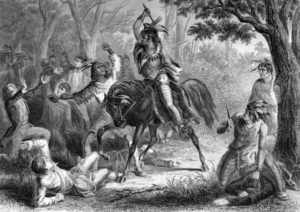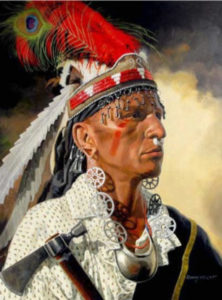 The Indians first mounted a large attack against white men in the Johnstown, Pa., area was during the Battle of the Monongahela in 1755. This was at the beginning of the French and Indian War. The French soldiers and Native American warriors joined to fight and defeat British General Edward Braddock.
The Indians first mounted a large attack against white men in the Johnstown, Pa., area was during the Battle of the Monongahela in 1755. This was at the beginning of the French and Indian War. The French soldiers and Native American warriors joined to fight and defeat British General Edward Braddock.
Braddock was mortally wounded during the battle and died near present-day Uniontown.
Years later, Native Americans started warring on their own against White settlers and the British.
“The Native Americans were upset over British laws being enforced by General Jeffrey Amherst,” said Scott Perry, museum facilitator at the Bushey Run Battlefield.
One problem was that Amherst cut off the Native American supply of gunpowder, which they had grown dependent on for their hunting.
This was named Pontiac’s War after one of the leading Native American generals. The Native American raids were initially quite successful and the conflict spread from the Great Lakes region eastward into Pennsylvania.
Col. Henry Bouquet was leading an expedition to help re-establish some forts in western Pennsylvania when his soldiers were attacked at Bushey Run. The battle that followed was a significant victory for the British and is said to have turned the tide of the war.
“Militarily, the British hadn’t known how to deal with the Native Americans,” Perry said. “However, the British not only defeated them, but defeated them in their own territories in their own kind of fight.”
Kittanning Trail
The Kittanning Trail was one of four major Indian trails that passed through Cambria County. It ran from Frankstown in Butler County, passing through Cambria County east of Carrolltown, and ended at Kittanning on the Allegheny River. It was used from 1721 to 1781, and helped bring white men into the region.
In the 1750s, Indians who were unhappy that they had lost much of their land rights because of the language of the “walking purchase”, would use the path to reach white settlements near the eastern end of the trail, raid them, and then retreat to Kittanning.
Col. John Armstrong pursued the Delaware Indian Shingas along the path in 1755 after Shingas had raided a white settlement and taken prisoners. Armstrong and his men went on to destroy Kittanning.
End of Hostilities
In the end, it was simply a matter of numbers. White settlers kept moving into the region and easily outnumbered the small Indian population. The Kittanning Trail was essentially abandoned by 1781.
“By 1800, most Indians whose original homelands were within Pennsylvania’s borders had moved out of the state to new homes in Ohio, Canada, or farther west. With the exception of a small Seneca community living in the northwest corner of the state, there were no officially recognized reservations or self-governing Indian communities remaining within Pennsylvania’s borders,” according to ExplorePaHistory.com.
Today
It’s hard to find traces of the Indians and White pioneers in the area nowadays. You can find some old cemeteries with the graves of white pioneers. One of these is Shanks Cemetery just south of the Chest Springs.
The Indian villages and original white settlements are gone or built over by modern incarnations like Johnstown being built where an Indian settlement had been. You can get an idea of what Indian villages of the time were like at the Fort Hill archaeological site near Confluence in Somerset County.
You can also visit the Bushey Run Battlefield and visitors’ center in Jeannette.
A section of the Kittanning Trail still exists at Carrolltown. It has been surveyed to match the original trail and preserved.
You might also enjoy these posts:
- The first residents of Johnstown (part 1)
- Pennsylvania”s Ghost Towns
- The Legacy of Battle: Pennsylvania College in the Post-Civil War Era